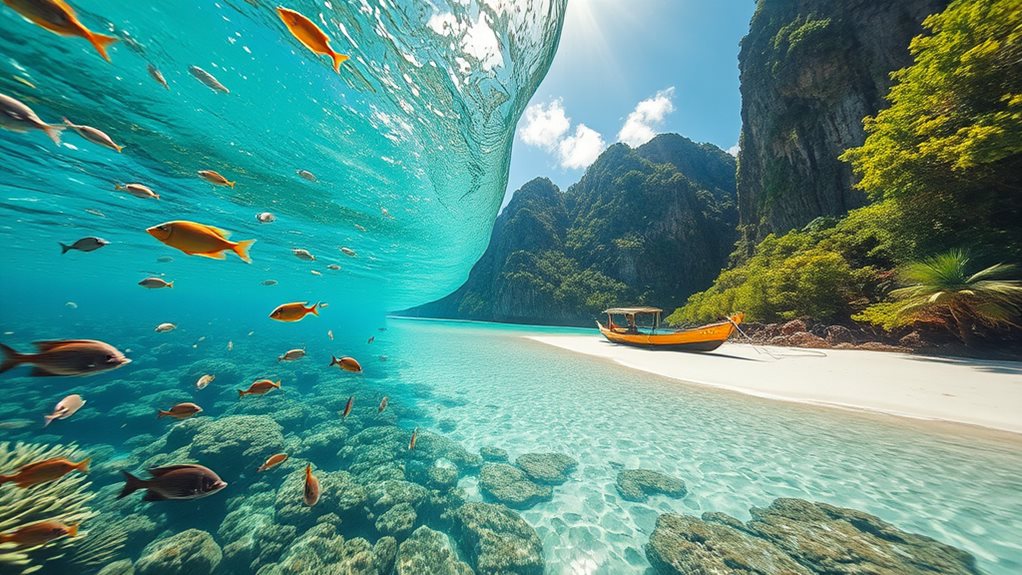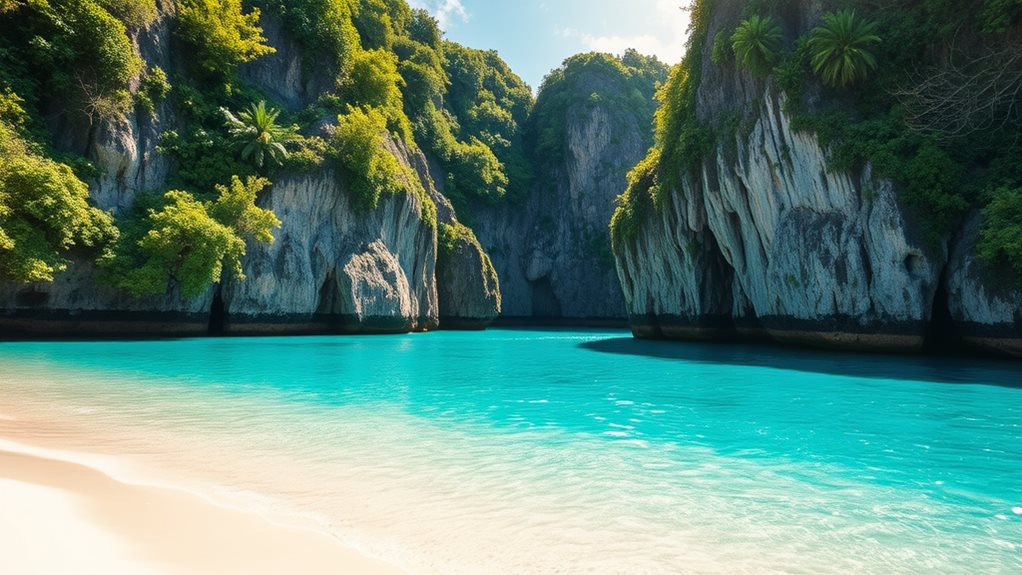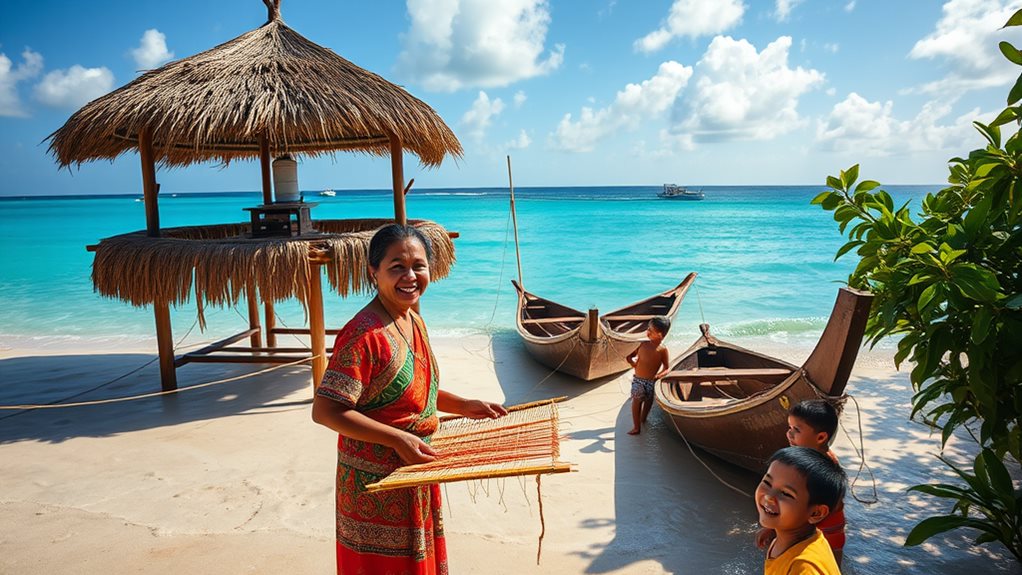Explore Caramoan's limestone cliffs and islands like Matukad (soft sand) and Lahos (tide-exposed beach). Swim, snorkel vibrant coral reefs in crystal-clear waters. Share a boat to reduce costs. Discover hidden coves and pristine beaches.
Unveiling Caramoan's Beauty

Caramoan: Untamed beauty reigns in northeastern Camarines Sur's Bicol Region. This peninsula, bordered by the Philippine Sea and Maqueda Channel, boasts a rugged landscape of hills, gorges, and rocky shores.
Pristine beaches, lush forests, lakes, and caves contrast this wildness.
Caramoan National Park (347 hectares) features limestone formations, islet lakes, and subterranean rivers.
Explore Matukad Island's rainforest and white sands, or Sabitang-Laya's beaches and snorkeling.
This first-class municipality (49 barangays, nearly 45,000 residents) thrives on fishing and burgeoning tourism. Family-run inns offer rustic charm. Its remote location preserves its unspoiled nature.
Caramoan is an Important Bird Area, home to the green racket-tail. *Survivor* filmed here.
Island Hopping Adventures
Caramoan's island-hopping tours depart from Bikal Boat Terminal or Paniman Beach. Boat rentals (good for six) cost 1500P ($30) for short trips and 2500P ($50) for long trips. Solo travelers can share. Tours may be cancelled in rough seas.
Explore Matukad Island (cliff jumping, clear waters), Lahos Island (rock formations, low-tide sandbar), Cotivas Island (sandbars, beaches), Sabitang Laya Island (limestone formations), and Manlawi Sandbar (large beach).
| Island | Features | Activities |
|---|---|---|
| Matukad | Cliff jumping, clear waters | Snorkeling, diving, swimming |
| Lahos | Rock formations, sandbar | Exploring, photography |
| Cotivas | Sandbars, beaches | Swimming, sunbathing |
Activities include snorkeling, diving, beach exploration, and cave exploration. Consider personalized tours or overnight camping. A 30P environmental fee applies at the port. Check weather conditions.
Caramoan's Natural Wonders

Caramoan boasts pristine white-sand beaches rivaling Boracay and El Nido. Lahos Island's sand appears and disappears with the tide; Matukad's sand is unbelievably soft.
Lahuy Island offers Nipa and Bugtong beaches, perfect for sunbathing. Paniman Beach's two-kilometer expanse is ideal for photography.
Towering limestone cliffs and dramatic rock formations punctuate the landscape. Matukad Island has a hidden lagoon; giant rocks separate Lahos Island's beaches.
Tinago and Pitogo islands feature unique rock formations; Gota Beach has Explorer's Rock.
Crystal-clear waters teem with marine life and coral reefs. Snorkel, kayak, or explore Matukad's lagoon. Swim at Cagbalinad or Paniman; enjoy fresh seafood and coconut juice.
Tayak Lake, accessible via a jungle trek, offers stunning views. Lahuy Island is dog-bone shaped; Guinahoan's lighthouse is a short hike away.
Manlawi Sandbar features low-tide sandbars and high-tide floating cottages; Pitogo Island has a pebble beach.
Reaching the Islands
Reach Naga City: Fly (1 hour, PHP 2,500-4,000).
Or take the bus (overnight, PHP 600-1,200).
Naga City to Sabang Port: Take a van from SM Mall (PHP 150, 1-2 hours).
Sabang to Guijalo Port: Take a boat (PHP 120, 2 hours; last boat 11:00 AM).
Guijalo Port fee: PHP 30.
Guijalo Port to Accommodation: Take a tricycle (PHP 10).
Local transport: Tricycle.
Local Culture and Life

Caramoan offers a glimpse into Bicolano culture, shaped by Spanish influence since the early 1600s but retaining strong indigenous traditions. Experience this heritage firsthand at the Isla Carahan and Balik Caramoan Festivals, showcasing crafts, music, dance, and the Bicolano language.
Locals are welcoming and often include visitors in celebrations. Discover stories of enchanted milkfish and the origin of the name "Caramoan" (originally "Carahan").
Sample traditional Bicolano cuisine like Laing, Pinangat, or Kinunot.
Visit St. Michael De Archangel Parish to understand the island's history. Caramoan's culture is vibrant and enduring.
Accommodation Options
Accommodations range from opulent resorts to budget-friendly guesthouses. Luxury options include Tugawe Cove Resort and Gota Village Resort (Survivor's filming location), offering beachfront access and exclusive amenities.
Luxury options also include West Peninsula Villas, which features a lake bar and videoke room. Emmalyn's Paradise Resort and Residencia de Salvacion also provide high-end comfort.
Budget travelers will find affordable inns, hostels, and guesthouses in the town center, including La Casa Roa Hostel.
Mid-range options include smaller family-run resorts.
What Makes Island Hopping on Palaui Island Different from the Caramoan Islands?
Island hopping on Palaui Island brings raw, untouched beauty with windswept beaches and rugged landscapes, offering a true escape into nature. Meanwhile, the Caramoan Islands captivate with their surreal limestone formations and hidden lagoons. Both promise unforgettable island hopping adventures, but Palaui’s pristine charm and Caramoan’s dramatic features create distinct experiences.
Activities and Things To Do

Caramoan Islands: Activities
Snorkel vibrant coral reefs at Cagbalinad and Lahos Islands.
Kayak the Sohoton River's unique rock formations.
Swim at Gota and Hunongan Cove beaches, or cliff jump from Matukad Island's 20-meter drop.
Island hop to Matukad's lagoons, Lahos' white sands and rock formations, and Hunongan Cove.
Snorkel Cagbalinad (note: poisonous sea snakes present).
See Manlawi Sandbar on a distant islands tour.
Rock climb Matukad's limestone cliffs to its enchanted lagoon.
Hike for panoramic views.
Explore Omang, Manipis, and Culapnit Caves.
Climb 524 steps to the Shrine.
Experience Caramoan's culture at festivals like Isla Carahan and Balik Caramoan.
Sample local crafts, seafood, and dishes like Bicol Express.
Planning Your Trip
Reach Caramoan from Cubao, Manila via a 1 PM or 3 PM Raymond Bus to Naga City.
Transfer to Sabang or Guijalo Port (PHP 1,500-2,500 boat fare);
total travel time: 10 hours.
Pre-book accommodations and tours, especially during peak season (March-May).
Local coordinators handle lodging and island hopping.
Budget PHP 60-100 per meal; town eateries close at 8 PM.
Tricycle rides cost roughly PHP 10.
Island hopping: PHP 1,500-2,500 (six people), or PHP 4,000 (combined tour).
Pack food; buy fresh seafood at local markets.
A three-day trip costs PHP 4,500-5,000 (excluding food).
Pack rain gear; night travel on challenging roads.
Practice sustainable tourism.